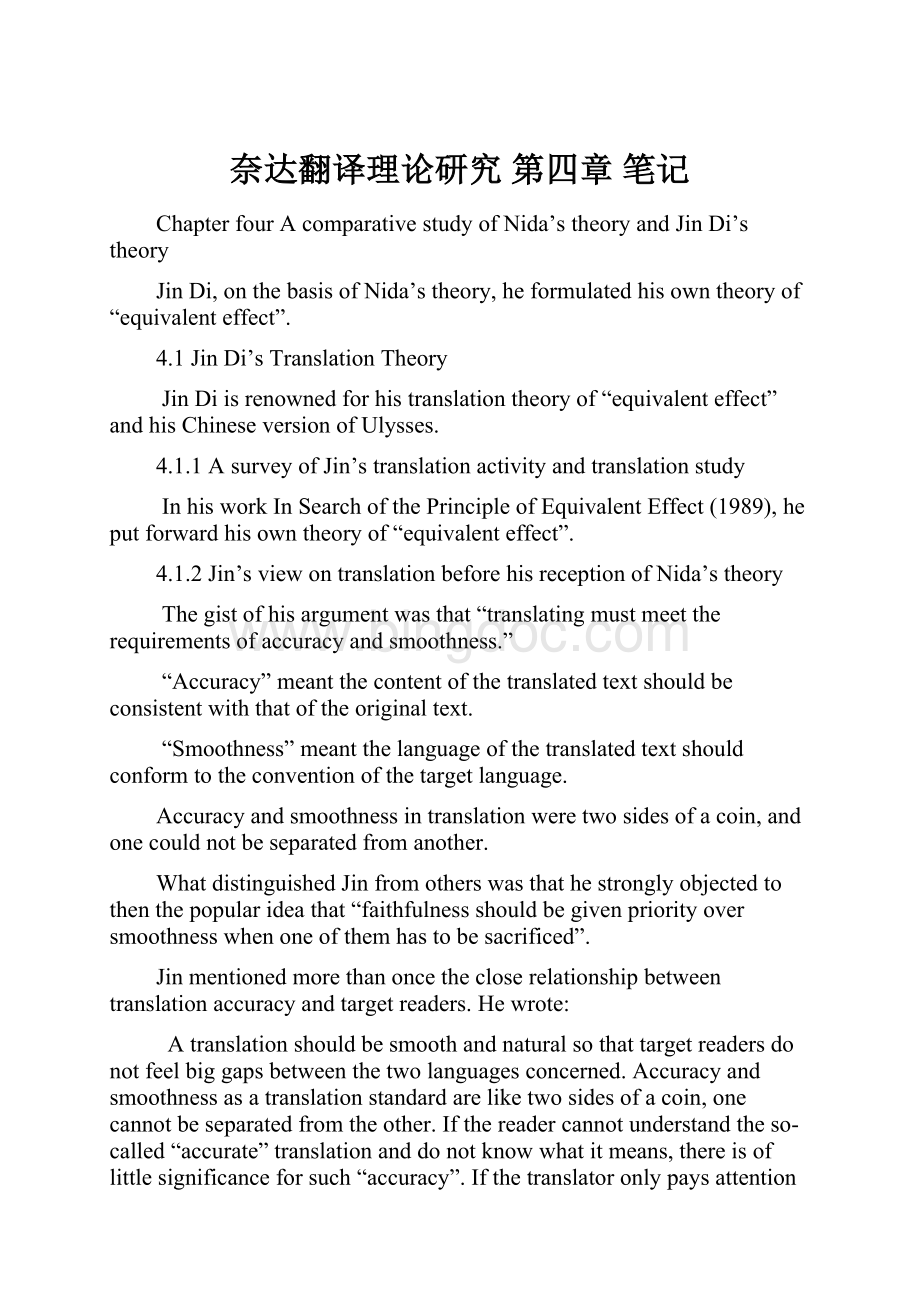奈达翻译理论研究第四章笔记.docx
《奈达翻译理论研究第四章笔记.docx》由会员分享,可在线阅读,更多相关《奈达翻译理论研究第四章笔记.docx(13页珍藏版)》请在冰点文库上搜索。

奈达翻译理论研究第四章笔记
ChapterfourAcomparativestudyofNida’stheoryandJinDi’stheory
JinDi,onthebasisofNida’stheory,heformulatedhisowntheoryof“equivalenteffect”.
4.1JinDi’sTranslationTheory
JinDiisrenownedforhistranslationtheoryof“equivalenteffect”andhisChineseversionofUlysses.
4.1.1AsurveyofJin’stranslationactivityandtranslationstudy
InhisworkInSearchofthePrincipleofEquivalentEffect(1989),heputforwardhisowntheoryof“equivalenteffect”.
4.1.2Jin’sviewontranslationbeforehisreceptionofNida’stheory
Thegistofhisargumentwasthat“translatingmustmeettherequirementsofaccuracyandsmoothness.”
“Accuracy”meantthecontentofthetranslatedtextshouldbeconsistentwiththatoftheoriginaltext.
“Smoothness”meantthelanguageofthetranslatedtextshouldconformtotheconventionofthetargetlanguage.
Accuracyandsmoothnessintranslationweretwosidesofacoin,andonecouldnotbeseparatedfromanother.
WhatdistinguishedJinfromotherswasthathestronglyobjectedtothenthepopularideathat“faithfulnessshouldbegivenpriorityoversmoothnesswhenoneofthemhastobesacrificed”.
Jinmentionedmorethanoncethecloserelationshipbetweentranslationaccuracyandtargetreaders.Hewrote:
Atranslationshouldbesmoothandnaturalsothattargetreadersdonotfeelbiggapsbetweenthetwolanguagesconcerned.Accuracyandsmoothnessasatranslationstandardareliketwosidesofacoin,onecannotbeseparatedfromtheother.Ifthereadercannotunderstandtheso-called“accurate”translationanddonotknowwhatitmeans,thereisoflittlesignificanceforsuch“accuracy”.Ifthetranslatoronlypaysattentiontosmoothnessinhiswork,butignorestheconsistencybetweentheoriginaltextandthetranslatedtext,histranslationisnotlegitimate.
4.1.3Jin’stheoryofequivalenteffectanditsrelationshipwithNida’stheory
InOnTranslation:
withspecialreferencetoChineseandEnglish,JinbasicallyadoptedNida’s“dynamicequivalence”,whichwasdefinedintermsofadynamicrelationship,namely,“therelationshipoftargetlanguagereceptorstothetargetlanguagetextshouldberoughlyequivalenttotherelationshipbetweentheoriginalreceptorsandtheoriginaltext”.
Thebookmentionedabovewasacclaimedas“amasterpieceofcombinationofNida’stranslationtheorywithChinesetranslationwithChinesetranslationpractice”.
JinarguedthatNida’stheorywasintendedtoguideBibletranslationforevangelism,andtheultimatepurposeofBibletranslatingwastomakereceptors“responsetothetranslatedmessageinaction”.Thus,accordingtoJin,theconceptof“response”inNida’stheorywasnotsuitableforatheoryofgeneraltranslation.Jinexplained:
Althoughreceptors’responsecouldbeusedasanimportantfeedbacktoevaluatehowthereceptorsunderstandandappreciatethetranslationtosomeextent,andthetranslatorcouldtestthequalityofhistranslationaccordingtoreceptor’sresponse,suchactivityoccursonlyafterthetranslationiscompleted.Sinceeachreceptor’sresponseandreactioninvolveanumberofsubjectiveandobjectivepersonalfactors,itisnecessaryforustoexplorethesefactorsinourstudyoftranslationprocess.Hence,inourdiscussiontheterm“effect”referstotheimpactofthetranslatedmessageuponthereceptorsinsteadofthereceptors’response.(ThiswasthereasonwhyJinmodifiedNida’s“dynamicequivalence”,andputforwardhisowntheoryof“equivalenteffect”.
等效定义(方式一):
theobjectiveofanequivalenteffecttranslationisthatalthoughtheformofatranslatedtextmaybedifferentfromthatoftheoriginaltext,thereceptor-languagereadercanobtainamessageassubstantiallythesameasthesource-languagereaderdoesfromtheoriginal,includingmainspirit,concretefactsandartisticimagery.
分析:
inJin’sview,onlywhenthethreeessentialfactors(“mainspirit,“concretefacts”and“artisticimagery”)oftheoriginalweresuccessfullyreproducedinthereceptorlanguagecouldatranslationbetermedasatranslationofequivalenteffect.
Inshort,thedelimitationoftheconceptof“effect”as“impact”insteadof“response”,andtheemphasisonthereproductionofthethreefactorsconstituteJin’stheoryof“equivalenteffect”.
Inhisarticle,“TranslatingSpirit”,heborrowedtwocharactersfromYanFu’sthree-charactertranslationprincipleandadvancedhistheoryof“faithfulness,expressivenessandspirit”(信,达,神韵).Theterm“spirit”inJin’stheorywasusedinabroadsense,indicatingvariousartisticstylesofliteraryworks.
等效定义(方式二):
thethree-characterprincipleof“faithfulness,expressivenessandspirit”indicatedthatfaithfulrepresentationofthefundamentalfacts,transferenceofeffectandreproductionofartisticstylerespectively.
InrecentyearsJinbegantoputmoreemphasisonthe“reproductionofartisticstyle”,andtriedtodevelophistheoryof“equivalenteffect”bymakinguseofChinesetraditionaltranslationtheoryandclassicliterarycriticism.
Jin’stheorydeviatedawayfromNida’stheorybecauseNida’stheoryfailstoadequatelyaddresstheproblemoftransferenceofaestheticvaluesinliterarytranslation;whileJin,havingattemptedtosolveit,hastoabsorbChinesetraditionaltranslationtheoryandclassicliterarycriticism,wherediscussionaboutstylisticoraestheticeffectsandtheirtransferenceareabundant.
4.2RethinkingNida’sdynamicequivalence
4.2.1Therelationshipbetweendynamicequivalenceandtheprincipleofequivalenteffect
Asearlyas1790,Tytlerstatedthatagoodtranslationwasoncein“whichthemeritoftheoriginalworkissocompletelytransfusedintoanotherlanguage,astobedistinctlyapprehended,andstronglyfelt,byanativeofthecountrytowhichthatlanguagebelongs,asitisbythosewhospeakthelanguageoftheoriginalwork”.Tytlerwasconsideredthefirstpersonwhohaddiscussedtheissueofequivalenteffectinthehistoryoftranslationtheory.ButitwasE.V.Rieuwhofirstusedtheexpression“theprincipleofequivalenteffect”todiscusstranslation.
Arnoldstatedthat“Atranslationshouldaffectusinthesamewayastheoriginalmaybesupposedtohaveaffecteditsfirsthearers”.
Jowettexpressedthat“Thetranslatorseekstoproduceonhisreaderanimpressionsimilarornearlysimilartothatproducedbytheoriginal”.
ThereasonwhyNida’stheoryisalsocalledtheprincipleof“equivalenteffect”inthewestisthat:
atranslationwhichattemptstoproduceadynamicratherthanaformalequivalentisbasedupon“theprincipleofequivalenteffect”.Insuchatranslationoneisnotsoconcernedwithmatchingthereceptor-languagemessagewiththesource-languagemessage,butwiththedynamicrelationship,thattherelationshipbetweenreceptorandmessageshouldbesubstantiallythesameasthatwhichexistedbetweentheoriginalreceptorsandthemessage.
4.2.2Thescientificbasisofdynamicequivalence/functionalequivalence
Nidaborrowstheconceptofthedecoder’schannelcapacityfrominformationtheorytoexplaintheacceptabilityofmessagebyreadersinbothoriginalcommunicationandtranslation.Andheprovesthatadynamicequivalenttranslationfitsthereceptor’schannelcapacitysoastodecodethetranslatedtextwitheaseandefficiencyinhisownculturaltext.
Theterm“dynamic”impliesascientificbasis.Thedynamicaspectisaboutacomparisonoftworelations,namely,“Therelationoftargetlanguagereceptorstothetargetlanguagetextshouldberoughlyequivalenttotherelationshipbetweentheoriginalreceptorsandtheoriginaltext”.Suchrelationshipindicatesthattranslatingisnotcompletedunlessthetranslatedmessageisreceivedbythereaderinthereceptorlanguageinsubstantiallythesamemannerastheoriginalmessageisreceivedbytheoriginalreader.
When“dynamicequivalence”isreplacedwith“functionalequivalence”inordertoavoidmisunderstandingsabouttheterm“dynamic”,Nida,havingdrawnupontheconceptofisomorphs,furtherjustifies“functionalequivalence”.Isomorphsareanextensionofthesemioticconceptof“iconicity”or“mattersoflikeness”.Functionalisomorphsaredefinedonthebasisofthemeansforaccomplishingessentiallythesameresultswithindifferentsystems.
Tosumup,“dynamicequivalence”/“functionalequivalence”isbasedontheprincipleof“equivalenteffect”.WhatdistinguishedNida’stheoryfromotherprincipleofequivalenteffectwasthatithadasolidscientificbasis,andNidaprovedthelegitimacyofhistheoryfrominsightscomingfromcommunicationtheoryandsociosemiotics.
4.2.3Theimmediateconcernofdynamicequivalence
Nidafurtherexplained“dynamicequivalence”inawaythatwasdirectlyrelevanttoBibletranslating:
Itwouldbewrongtothink,however,thattheresponseofthereceptorsinthesecondlanguageismerelyintermsofcomprehensionoftheinformation,forcommunicationisnotmerelyinformative.ItmustalsobeexpressiveandimperativeifitistoservetheprincipalpurposesofcommunicationssuchasthosefoundintheBible.Thatistosay,atranslationoftheBiblemustnotonlyprovideinformationwhichpeoplecanunderstandbutmustpresentthemessageinsuchawaythatpeoplecanfeelitsrelevanceandcanthenrespondtoitinaction.
4.3Jin’sroleinpopularizingNida’stheory
4.3.1Jin’scontributiontoabetterunderstandingofNida’stheory
JinrightlycommentedonNida’scontributiontotheprincipleof“equivalenteffect”:
ThegreatcontributionEugeneNidamadewastoshiftthefocusthecomparisontexts,thesource-languageandthetarget-languagetexts,toacomparisonofthetwocommunicationprocessesinvolved.Asthemessageinacommun